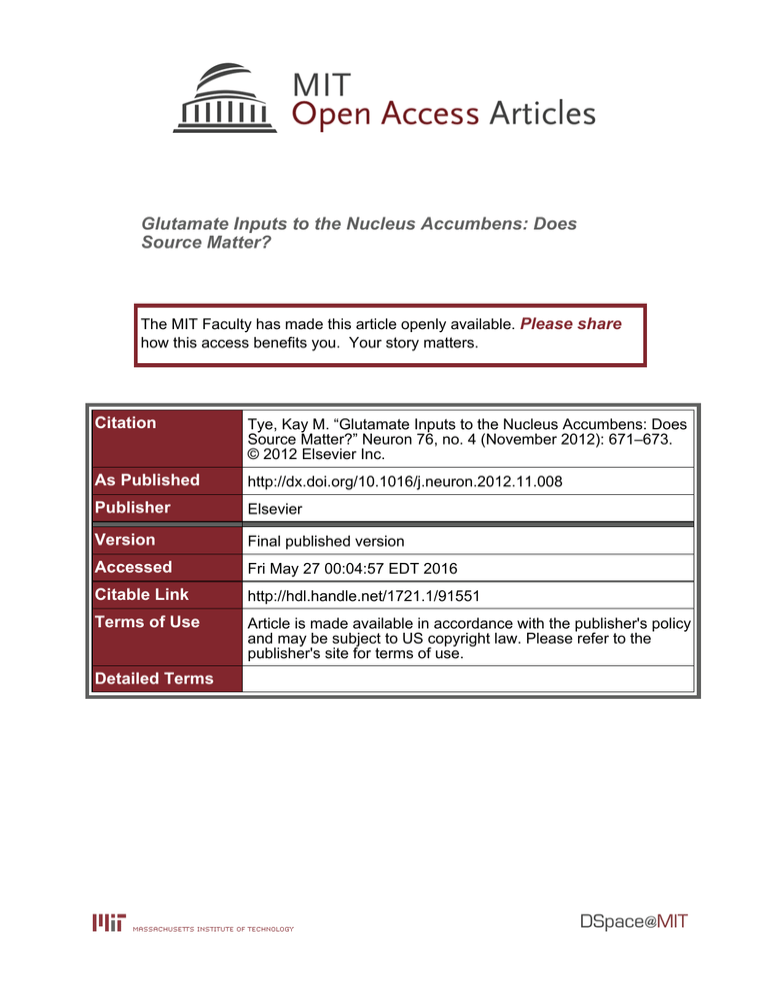Glutamate Inputs to the Nucleus Accumbens: Does Source Matter? Please share
advertisement

Glutamate Inputs to the Nucleus Accumbens: Does Source Matter? The MIT Faculty has made this article openly available. Please share how this access benefits you. Your story matters. Citation Tye, Kay M. “Glutamate Inputs to the Nucleus Accumbens: Does Source Matter?” Neuron 76, no. 4 (November 2012): 671–673. © 2012 Elsevier Inc. As Published http://dx.doi.org/10.1016/j.neuron.2012.11.008 Publisher Elsevier Version Final published version Accessed Fri May 27 00:04:57 EDT 2016 Citable Link http://hdl.handle.net/1721.1/91551 Terms of Use Article is made available in accordance with the publisher's policy and may be subject to US copyright law. Please refer to the publisher's site for terms of use. Detailed Terms Neuron Previews Glutamate Inputs to the Nucleus Accumbens: Does Source Matter? Kay M. Tye1,* 1Picower Institute for Learning and Memory, Department of Brain and Cognitive Sciences, Massachusetts Institute of Technology, Cambridge, MA 02139, USA *Correspondence: kaytye@mit.edu http://dx.doi.org/10.1016/j.neuron.2012.11.008 How the nucleus accumbens integrates information from multiple upstream regions has been a central question for decades. In this issue of Neuron, Britt et al. (2012) photostimulate glutamatergic axons from the amygdala, prefrontal cortex, and hippocampus in the nucleus accumbens, characterizing the functional role of each pathway both in vivo and ex vivo. The nucleus accumbens (NAc) has been described as a crucial convergence point for information about environmental contexts and cues before the selection and execution of a final motor output and has long been known to be important in the processing of reward-related behaviors (Cardinal et al., 2002; Carelli, 2002), specifically in the context of cocaine-induced plasticity (Thomas et al., 2001; Boudreau and Wolf, 2005). What happens at this last stop? Three of the most robust glutamatergic inputs to the NAc are the basolateral amygdala (Amyg), medial prefrontal cortex (PFC), and the ventral hippocampus (vHipp), each probed by Britt et al. (2012) using optogenetic methods (Figure 1). This characterization revealed many novel insights: while Britt et al. (2012) confirmed some assumptions about these limbic systems, they challenged the dogma surrounding NAc information integration. The most provocative implication of this paper is that Britt et al. (2012) raise ‘‘the possibility that the specific pathway releasing glutamate is not as important as the amount of glutamate that is released.’’ This is indeed a new concept that would change the way much of the field thinks about the way that the NAc integrates information: what if the complex computations are actually much simpler than we thought? What if projection origin matters less than projection target? More than half a century ago, intracranial self-stimulation (ICSS) was first used to identify several fiber tracts, including putative hippocampal outputs, as neural substrates for reward or reinforcement (Olds and Milner, 1954). However, these seminal studies used electrical stimulation—nonspecifically activating multiple cell types and axons of passage—making it difficult to determine the critical neural circuit element with confidence. In another seminal study from the 1990s, elegant in vivo intracellular recordings in anesthetized animals first characterized the role of hippocampal, prefrontal cortical, and amygdalar inputs to the NAc, demonstrating distinct properties of electrical stimulation in each upstream region (O’Donnell and Grace, 1995). O’Donnell and Grace established the unique ability of hippocampal inputs to the NAc to induce changes in membrane potential, commonly referred to as ‘‘up and down states’’—medium spiny neurons were pushed into step-function-like states in which the cells were slightly depolarized and more excitable in response to prefrontal cortical inputs (O’Donnell and Grace, 1995). Distinct from the bistable responses elicited by fornix stimulation, electrical stimulation of the amygdala produced longer-lasting depolarization with greater onset latency, and electrical stimulation of the prefrontal cortex elicited a fast, but transient, depolarization (O’Donnell and Grace, 1995). Until the development of optogenetic projectionspecific targeting approaches, we did not have the ability to manipulate axons originating in specific regions during freely moving behaviors nor to stimulate axons arriving from a known source in acute slice preparations (Tye et al., 2011; Stuber et al., 2011). Optogenetic-mediated projection-specific targeting leverages the genetically encodable capability of these lightsensitive proteins and allows for the selective activation of specific populations of cells and axons. However, caveats still include the possibility of depolarizing axons of passage that do not form synapses in the illumination field or the induction of backpropagating action potentials (Petreanu et al., 2007), also known as antidromic stimulation, which may scale with stronger illumination parameters, opsin expression levels, and the specific characteristics of the preparation. These early studies in optogenetic projection-specific targeting used local pharmacological manipulations, blocking glutamate receptors in the postsynaptic target region to demonstrate that the behavioral changes observed were indeed due to local effects—ruling out the possible contribution of axons of passage or antidromic activation to the light-induced behavioral change (Tye et al., 2011; Stuber et al., 2011). Stuber and colleagues investigated two of the same projections, specifically testing the ability of amygdalar and prefrontal cortical inputs of the NAc to support ICSS, by expressing channelrhodopsin-2 (ChR2), a light-activated cation channel, in glutamatergic pyramidal neurons of the amygdala or prefrontal cortex and implanting an optical fiber into the medial shell of the NAc. They observed that amygdalar, but not prefrontal cortical, inputs to the NAc supported ICSS (Stuber et al., 2011). In this issue of Neuron, Britt et al. (2012) put forth an article of impressive breadth, characterizing three pathways from anatomical, electrophysiological, Neuron 76, November 21, 2012 ª2012 Elsevier Inc. 671 Neuron Previews and behavioral perspectives (FigWhile they replicated the finding ure 1). Anatomically, Britt et al. that photostimulation of Amyg (2012) examined the patterns of axons in the NAc could support axons expressing a fluorescent reward-related behaviors (Stuber protein in the NAc from the et al., 2011), in contrast to earlier vHipp PFC Amyg, PFC, and vHipp, revealing work from this group, they found the unique distribution of axons that illuminating ChR2-expressing throughout the NAc in exquisite PFC neurons could also support Glu detail across multiple animals (Britt ICSS. This discrepancy can be Glu et al., 2012), largely consistent with reconciled by several experimental earlier studies (Voorn et al., 2004). details; Britt et al. (2012) performed They also investigated the propera more robust activation of PFC ties of synaptic transmission from axons in the NAc by using bilateral NAc Glu each of these pathways using stimulation and illumination parameex vivo whole-cell patch-clamp reters at a 50% higher frequency and D cording techniques in acute slice train duration. This difference highAmyg M L preparations of different animals lights the importance of titrating opV expressing ChR2 in one of the togenetic experimental parameters upstream regions (Amyg, PFC, or in much the same way as pharmavHipp). These experiments revealed cological experiments, using light new insights about the relative and/or viral ‘‘dose-dependent strength of light-evoked excitatory curves.’’ postsynaptic currents (EPSCs), Finally, yet another surprising showing that vHipp inputs evoked result emerged from this study with their ability to support ICSS with the greatest EPSC amplitudes in nonspecific MSN activation (Britt the NAc shell, with the PFC inputs evoking the smallest EPSC ampliet al., 2012). In the NAc (Lobo tudes of the three (Britt et al., et al., 2010), D1 and D2 receptorFigure 1. Schematic Representation of Glutamatergic 2012). This was not a result of expressing cells showed opposing Inputs to the Nucleus Accumbens from the Medial Prefrontal Cortex, Ventral Hippocampus, and varying sensitivity or composition effects on reward-related behaviors. Basolateral Amygdala and Their Manipulation in the of postsynaptic AMPARs for each However, when examining the data Freely Moving Mouse input, as demonstrated by the from these studies, the degree to As described by Britt et al. (2012) in this issue of Neuron, bilatnearly identical amplitudes of quanwhich activation of D1 receptoreral activation of axons in the NAc originating from each of these upstream regions were characterized during rewardtal release and indistinguishable expressing neurons was positively related behaviors. Although this figure is not drawn to scale current-voltage relationships across reinforcing may have overpowered and multiple anteroposterior coordinates were collapsed, synapses, respectively (Britt et al., the aversive properties of D2 from a coronal slice perspective, dorsal (D), ventral (V), medial (M), and lateral (L) are indicated. NAc, nucleus accumbens; 2012). However, Britt et al. (2012) receptor-expressing neuronal actiPFC, medial prefrontal cortex; vHipp, ventral hippocampus; did observe that the vHipp-NAc vation in the NAc, leading to a net Amyg, basolateral amygdala. synapses showed greater NMDAReffect of positive reinforcement. mediated inward currents, which This finding led Britt et al. (2012) to could explain the unique ability of this limbic and infralimbic regions and re- suggest that perhaps the source of glutainput to induce the stable depolarization corded from all MSNs. Given the oppos- matergic innervation was less important seen in ‘‘up and down states’’ of NAc ing functions observed in both prelimbic than the bulk amount of glutamate MSNs (O’Donnell and Grace, 1995). and infralimbic cortices as well as D1 released into the medial shell of the NAc. Electrophysiologically, there is a unique and D2 receptor-expressing neurons, this While this might not be true in physiofeature that Britt et al. (2012) identified of may have resulted in a ‘‘zero-sum’’ effect logical settings, where glutamate release vHipp-NAc synapses: they were exclu- when pooled together. Perhaps vHipp is governed by the natural spiking of sively potentiated after cocaine treat- inputs to the medial shell of the NAc pref- neurons rather than robust trains at ment. In contrast to Pascoli et al. (2012), erentially formed synapses on D1-type frequencies only seen in bursting pyrathey did not observe a cocaine-induced MSNs, though testing this hypothesis midal neurons, Britt et al. (2012) certainly potentiation of PFC inputs to the NAc would require additional experiments. put forth a host of new questions. The (Pascoli et al., 2012). This might be exBehaviorally, the inhibition of vHipp subtleties of this study need to be explained by the fact that Pascoli and axons in the NAc reduced, while activa- plored, particularly given the caveats colleagues investigated only infralimbic tion increased, cocaine-induced locomo- that the Amyg, vHipp, and PFC are all inputs to D1 receptor-expressing medium tion (Britt et al., 2012). Britt et al. (2012) robustly and reciprocally connected to spiny neurons (MSNs) in the NAc, while also demonstrated that illumination of each other. While they may provide direct Britt et al. (2012) expressed ChR2 vHipp axons in the NAc supported ICSS input to the NAc, further experiments are throughout the mPFC including both pre- and real-time place preference (RTPP). needed to confirm that monosynaptic 672 Neuron 76, November 21, 2012 ª2012 Elsevier Inc. Neuron Previews input from each of these inputs is sufficient to support reward-related behaviors. An important caveat to note for nearly all optogenetic studies published to date is that the use of cylindrical optical fibers with blunt-cut tips creates a relatively narrow and small cone of light that may not capture all of the axon terminals expressing ChR2—particularly in large structures such as the NAc, which is organized spherically rather than cylindrically. Here, Britt et al. (2012) looked only at the medial shell of the NAc, but other recent studies in the NAc core or lateral shell could have different effects, as recently suggested (Lammel et al., 2012). Another possibility raised by Lammel and colleagues is that multiple distinct experiential qualities could support ICSS, including salience, alertness, motivation, and hedonic pleasure in addition to general reward and reinforcement (Lammel et al., 2011). It would also be interesting to characterize the ultrastructural organization across the NAc of axonal terminals arriving from the vHipp, PFC, and Amyg—how often do these axon terminals synapse onto the same cell, and how are these interactions assem- bled (axoaxonal synapses, on the same dendritic arbor, etc.)? To conclude, even with the recent flood of insights toward causal relationships between the brain and behavior facilitated by optogenetic approaches (Tye and Deisseroth, 2012), there is still much to do. The paper from Britt et al. (2012) in this issue of Neuron makes an important contribution to the field by providing multiple new insights, raising provocative new questions, and opening the floodgates even wider than before to invite more research in this exciting new arena of systems neuroscience. Lammel, S., Lim, B.K., Ran, C., Huang, K.W., Betley, M.J., Tye, K.M., Deisseroth, K., and Malenka, R.C. (2012). Nature 491, 212–217. Lobo, M.K., Covington, H.E., 3rd, Chaudhury, D., Friedman, A.K., Sun, H., Damez-Werno, D., Dietz, D.M., Zaman, S., Koo, J.W., Kennedy, P.J., et al. (2010). Science 330, 385–390. O’Donnell, P., and Grace, A.A. (1995). J. Neurosci. 15, 3622–3639. Olds, J., and Milner, P. (1954). J. Comp. Physiol. Psychol. 47, 419–427. Pascoli, V., Turiault, M., and Lüscher, C. (2012). Nature 481, 71–75. Petreanu, L., Huber, D., Sobczyk, A., and Svoboda, K. (2007). Nat. Neurosci. 10, 663–668. Stuber, G.D., Sparta, D.R., Stamatakis, A.M., van Leeuwen, W.A., Hardjoprajitno, J.E., Cho, S., Tye, K.M., Kempadoo, K.A., Zhang, F., Deisseroth, K., and Bonci, A. (2011). Nature 475, 377–380. REFERENCES Boudreau, A.C., and Wolf, M.E. (2005). J. Neurosci. 25, 9144–9151. Britt, J.P., Benaliouad, F., McDevitt, R.A., Stuber, G.D., Wise, R.A., and Bonci, A. (2012). Neuron 76, this issue, 790–803. Cardinal, R.N., Parkinson, J.A., Hall, J., and Everitt, B.J. (2002). Neurosci. Biobehav. Rev. 26, 321–352. Carelli, R.M. (2002). Behav. Cogn. Neurosci. Rev. 1, 281–296. Lammel, S., Ion, D.I., Roeper, J., and Malenka, R.C. (2011). Neuron 70, 855–862. Thomas, M.J., Beurrier, C., Bonci, A., and Malenka, R.C. (2001). Nat. Neurosci. 4, 1217– 1223. Tye, K.M., and Deisseroth, K. (2012). Nat. Rev. Neurosci. 13, 251–266. Tye, K.M., Prakash, R., Kim, S.-Y., Fenno, L.E., Grosenick, L., Zarabi, H., Thompson, K.R., Gradinaru, V., Ramakrishnan, C., and Deisseroth, K. (2011). Nature 471, 358–362. Voorn, P., Vanderschuren, L.J.M., Groenewegen, H.J., Robbins, T.W., and Pennartz, C.M. (2004). Trends Neurosci. 27, 468–474. Rules Got Rhythm Andreas K. Engel1,* 1Department of Neurophysiology and Pathophysiology, University Medical Center Hamburg-Eppendorf, Martinistr. 52, 20246 Hamburg, Germany *Correspondence: ak.engel@uke.de http://dx.doi.org/10.1016/j.neuron.2012.11.003 Intelligent agents must select and apply rules to accomplish their goals. In this issue of Neuron, Buschman et al. (2012) demonstrate that oscillatory neuronal coupling is key to rule processing in monkey prefrontal cortex, notably when rules change during tasks. Our lives are governed by rules. Whether we are engaged in sports, school, traffic, shopping, or work, it is necessary to know ‘‘the rules of the game.’’ Knowledge of rules is indispensable in projecting the consequences of our actions and predicting which action may help us achieve a particular goal (Miller and Cohen, 2001; Bunge, 2004). The concept of a ‘‘rule’’ refers to a learned association between a stimulus (e.g., a red traffic light) and a response (stopping the car) that can guide appropriate behaviors. A typical feature of rules is that the mapping between stimulus and action is context dependent—a yellow traffic light may suggest pressing the brakes or the gas, depending on other contextual signals (Miller and Cohen, 2001). Of critical importance in real-life environments is the ability to flexibly switch between rules. A change of rules can dictate that the same stimulus warrants a different course of action than it did a few minutes before (e.g., either filling or cleaning your favorite coffee mug). Neuron 76, November 21, 2012 ª2012 Elsevier Inc. 673

